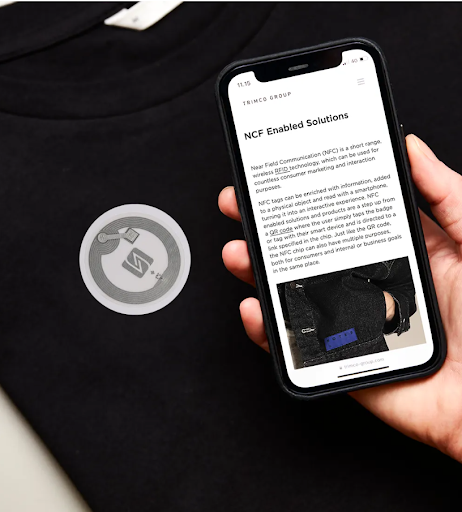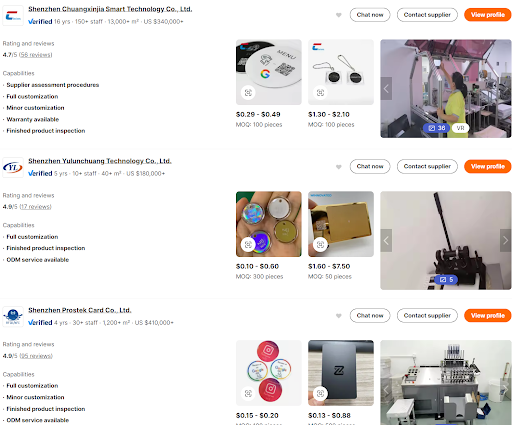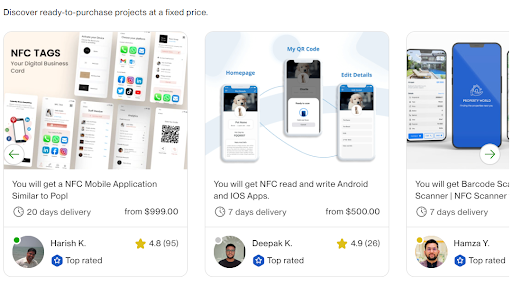How to Engage Your Amazon Customers with NFC
Integrating NFC technology into your products can enhance your customers’ product interaction, gather valuable data, and create memorable experiences that drive customer loyalty and boost sales. The NFC Tag Chip Market is witnessing a significant surge in growth, driven by the widespread adoption of Near Field Communication (NFC) technology across various industries.

Understanding NFC Technology
NFC, or Near Field Communication, is a type of wireless technology that allows two devices to communicate with each other when they are close together—usually within a few centimeters. It’s similar to Bluetooth but much simpler, faster, and with a shorter range.
NFC is commonly used in everyday items like contactless payment systems, where you tap your credit card or smartphone to pay for items without swiping or inserting your card. In the U.S. alone, contactless payments accounted for 30% of all card transactions in 2022, up from just 3% in 2019, highlighting the rapid adoption of NFC technology.
At its core, NFC uses radio waves to transmit small amounts of data between an NFC-enabled device, like a smartphone, and another NFC tag or device. These tags are small, often just stickers or embedded chips, that don’t need a battery to work.
When you bring an NFC-enabled device close to an NFC tag or another device, the two can instantly exchange information. For example, you can tap your phone to an NFC tag embedded in a product label to get detailed product information, open a website, or even download an app.
Globally, the NFC market is expected to reach $34.9 billion by 2026, growing at a CAGR of 14.2% from 2021 to 2026. This growth underscores the increasing importance and integration of NFC technology across various industries.
Unlocking Customer Engagement with NFC
For sellers, using NFC in their products opens up new ways to engage with customers and gather valuable data. By using NFC, sellers can easily collect contact details, offer personalized promotions, and keep the conversation going even after the sale.
A great example of NFC in action is McDonald's UK "Tap and Win" campaign. McDonald's implemented NFC technology to boost customer engagement, sales, and enhance their loyalty program. By allowing customers to tap their NFC-enabled smartphones on in-store materials, McDonald's achieved a 7% increase in customer engagement and recorded over 1.5 million interactions. The campaign led to a 3.5% sales increase, with average transaction values rising by 12%. Loyalty sign-ups grew by 20%, and redemption rates were 15% higher compared to non-NFC campaigns. Customer satisfaction was also high, with 85% of participants enjoying the NFC experience, resulting in a 10% increase in repeat visits.

For customers, NFC adds convenience and interactivity. They can access product details, videos, or special offers with a simple tap of their phone—no need to scan a code or type in a URL.
In apparel, a tap on an NFC tag could show care instructions or styling tips. In electronics, it might offer a quick start guide or troubleshooting tips. For home goods, it could link to assembly videos or complementary products.
To access NFC content, all a customer needs to do is bring their phone within 4 cm of the NFC chip in your product. The content will pop up automatically—no app download needed.
Choosing the Right NFC Chip
When choosing the right NFC chip for your product, it’s important to consider both functionality and compatibility. NFC chips come in various types, such as Type 1, Type 2, Type 3, and Type 4, each differing in memory size, data transfer speed, and security features.
For simple tasks like linking to a website, Type 1 or Type 2 chips are sufficient. For more complex interactions, such as payments or data storage, Type 3 or Type 4 chips are better options.
The cost of NFC chips varies based on their type and features. Basic NFC chips can start as low as $0.10 to $0.20 per unit, while more advanced chips with higher security and storage may range from $0.50 to $2.00 or more per unit.
Placing NFC Chips in Your Product
For product packaging, place the NFC chip where it won’t interfere with the packaging’s function or aesthetics—such as within a fold or along the edges. Ensure the chip is securely fixed to avoid damage during shipping or handling.
If embedding NFC directly into the product, choose a location that’s both discreet and easily accessible to customers. This might be on the underside of a label, within a tag, or inside a small compartment.
Also, make sure the NFC chip aligns with your product’s design. For instance, if you’re selling clothing, embed the chip in a tag that blends with the fabric but is easily reachable for scanning. The goal is to integrate the NFC chip in a way that enhances the user experience without compromising the product’s look or functionality.
Finding NFC Manufacturers
Start by researching manufacturers who specialize in NFC technology and custom electronics. You can search for them on platforms like Alibaba and Global Sources.

When reaching out to manufacturers, be clear about your product's needs and find out what all they’ve done in NFC before. Most manufacturers will have a minimum order quantity (MOQ), which can range from 500 to 10,000 units depending on their size and capabilities. Their lead times will vary, but expect anywhere from 4 to 8 weeks for production.
Easy NFC Chip Programming
Programming an NFC chip might sound tricky, but it’s easier than you think. First, you’ll need an NFC writer tool or app to encode the chip with your desired information, like a URL or contact details. To easily create and program NFC tags, consider using tools like NFC Tools, NXP TagWriter, or GoToTags Desktop, which offer user-friendly interfaces and robust features for both beginners and advanced users.
If you’re not tech-savvy, don’t worry—your supplier should be able to do this for you. If not, there are plenty of freelancers on platforms like Upwork who specialize in NFC programming and can do it quickly and affordably.

This programming allows customers to access information, watch videos, or even shop directly from their phones. Once programmed, the chip is ready to go and can be embedded in your product or packaging.
The good news is that even after your products are shipped, you can still change the destination URL. This is possible if you use a dynamic NFC chip, which allows you to update the linked content remotely without physically accessing the chip.
Engaging Customers with NFC Technology

Imagine a customer buying a pair of running shoes and, with a simple tap of their phone on the shoe tag, receiving a personalized workout plan based on their fitness goals. Or consider a skincare brand where customers can tap the NFC chip embedded in the packaging to get tailored skincare routines and product recommendations based on their skin type.
These personalized touches make customers feel special and connected to your brand, increasing the chances they’ll return for future purchases. By offering unique content like exclusive discounts, how-to videos, or product usage tips through NFC chips, you create a more engaging and interactive experience.
To collect customer details through NFC, start by making the interaction effortless and rewarding. For example, when a customer taps their phone on the NFC-enabled product, direct them to a simple landing page offering a discount or exclusive content in exchange for their email. This encourages sign-ups without feeling intrusive.
Additionally, you can prompt customers to follow your brand on social media by offering instant access to a special offer or a loyalty program.
Another effective strategy is to tie the NFC experience to a customer survey or feedback form. For instance, after a purchase, the NFC chip can guide customers to a quick survey, rewarding them with a coupon for their next purchase. This approach not only gathers valuable feedback but also helps you collect contact details in a way that feels beneficial to the customer.
Examples from Other Brands
Adidas, a pioneer in integrating NFC into fashion, began embedding NFC tags in its sneakers in 2014. Similarly, Nike had embraced NFC technology in its sneakers, enhancing customer interaction and authenticity verification, following a path similar to Adidas.
Bulgari has utilized NFC technology by embedding tags in its leather goods since 2021. This allowed customers to verify the authenticity of their purchases and access detailed information about the product’s origin and craftsmanship directly in-store.
Avoiding NFC Integration Mistakes
A common mistake is choosing low-quality NFC chips that may fail to connect with smartphones, causing frustration. Another pitfall is not thoroughly testing the chips in different environments and devices before launch, which can lead to issues with compatibility and performance.
Do focus on clear instructions for customers on how to use the NFC feature, enhancing their experience. On the flip side, don’t neglect the importance of securing customer data. Ensure your NFC interactions comply with privacy regulations to avoid potential legal issues.
Avoid overloading the NFC interaction with too much information, which can overwhelm or confuse users. Instead, keep the content concise and relevant to ensure a smooth and engaging experience.
Conclusion
Incorporating NFC technology into your products not only enhances customer engagement but also opens up new avenues for collecting valuable data and delivering personalized experiences. As demonstrated by leading brands, NFC is potentially a powerful tool for creating memorable interactions in today’s competitive Amazon marketplace.
--
Ben Mathew, Amazon Expert
Ben Mathew is a co-founder at Superfuel, a sales assistant for Amazon sellers. In the past, Ben and his team of e-commerce specialists and software engineers have launched 40+ new brands on Amazon, taking them from zero to bestsellers. In his free time, he is either learning from other top sellers or encouraging his 3 daughters in their love for reading. He is reachable at ben [at] superfuel.io.